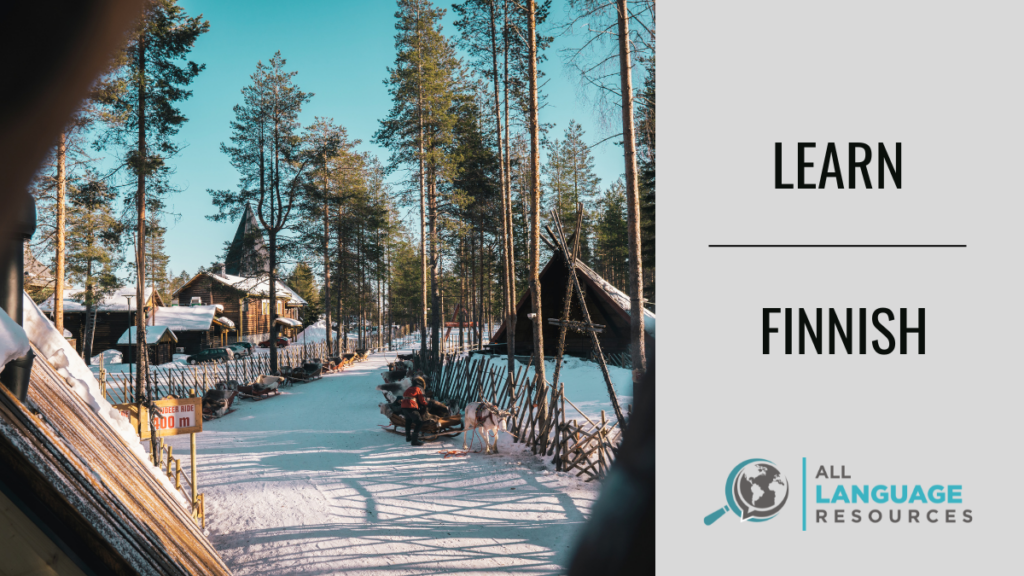Born somewhere between the snow forests of the Ural Mountains and the bend of the mighty Volga, the Finnish language has thrived against great odds.
It has been spoken by Nobel laureates, telecommunications engineers at Nokia, and Linus Torvalds, the inventor of a renowned computer operating system.
- About the Finnish Language
- Is Finnish Hard to Learn?
- How to Learn Finnish As an English Speaker
- What’s the Best Way to Learn Finnish?
- What’s the Easiest Way to Learn Finnish?
- How Long Does It Take to Learn Finnish?
- Learn to Speak Finnish
- Your Plan for Learning Finnish
- Resources to Help You Learn Finnish
- Where to Learn Finnish: Media Resources for Learning Finnish
- Related Posts
Elias Lönnrot, the writer of the saga that influenced Tolkien’s Middle Earth, came from Finland — as did Eero Saarinen, the designer who inspired the tulip-style chairs in Star Trek. So did composer Jean Sibelius, whose tone poem Finlandia is considered Finland’s national hymn…with a tune that echoes in Christian churches around the world.

A likeness of Finnish composer Jean Sibelius, part of Eila Hiltunen’s Sibelius Monument in Helsinki, Finland
Start learning Finnish with confidence using our comprehensive guide. Is Finnish hard to learn? What’s the easiest and best way to learn Finnish? Find out here.
About the Finnish Language
Despite how Finnish flourishes today, it had to overcome years of suppression and stigmas, even in its native land. For centuries, Finland was annexed and occupied by forces from both Sweden and Russia — two powers that were locked into geopolitical and religious conflict with each other.
Finland was a Swedish territory for nearly seven hundred years, starting in 1120. During the time of Swedish control, the Finnish language took a back seat to three other languages: Swedish was used for government and administrative purposes; Latin dominated the churches; Middle Saxon (also called Middle Low German) was the language of commerce. Because of the political situation, Finnish speakers were relegated to a secondary status in society, unable to use their native language in any official capacity.

Helsingin tuomiokirkko (Helsinki Cathedral)
For centuries, Finnish was not taught or used in written form. This all changed in the mid-16th century when Mikael Agricola, the Lutheran Bishop of Turku, decided to translate the New Testament into Finnish to make it more accessible for his fellow Finns. Agricola realized that he needed to standardize Finnish writing and spelling, in order to make his translation project work.
Agricola’s efforts led to the development of the modern Finnish language. To this day, Finns commemorate the April 9 anniversary of Agricola’s 1557 death, which has been declared the national day of the Finnish language. (Coincidentally, it’s also the birthday of Elias Lönnrot, who wrote the best-known Finnish epic poem.)

Mikael Agricola, by Albert Edelfelt (1854–1905) PD-US (Public domain in the United States, its country of origin, and other countries where the copyright term is the author’s life plus 100 years or fewer.)
Finnish faced further challenges in the early 18th century, when it was occupied by Russia during the latter country’s Great Northern War with Sweden, as well as the Russo-Swedish War of 1741-1743. Just as under Swedish rule, a foreign language — in this case, Russian — dominated the upper social strata of Finland. Even so, the Russian government did not obstruct the efforts of Johan Vilhelm Snellman and the Fennoman movement to make Finnish an official language in its native land.
Throughout the 19th century, Finland was subject to further incursions and violence from neighboring countries. From 1809 through 1917, Finland functioned semi-autonomously as the Grand Duchy of Finland. Although the Grand Duchy’s government had some freedom of self-determination in the beginning and saw steady economic growth, Russian control grew stricter and more dominant over time.
In 1917, when the Russian Empire fell, Finland declared its independence. Finns still celebrate their independence each year on December 6. Now, Finnish is the predominant language in Finland — in government, education, and everyday life.
Language Family, Related Languages, and Dialects
Unlike languages such as English, Swedish, Norwegian, French, Pashto, Persian, German, Greek, or Russian, Finnish is not an Indo-European language.
Finnish — called suomi by its native speakers — is a Uralic language, like Hungarian and Estonian. It’s one of two official languages spoken in Finland, used every day by 90% of the Finnish population. By way of contrast, Swedish — Finland’s other official language — is only spoken by about 5% of the population.
Mirroring this, Finnish is a minority language in Sweden, as well as a recognized minority language in Karelia and Russia. Finnish is also an official language of the European Union and the Nordic Council, and is sometimes used in the Finnish part of Sápmi (the indigenous name for Lapland), the traditional home of the Sámi (Saami) people.

Aurora borealis in Finnish Lapland
The Finnish language counts 5.8 million speakers, of which 5.4 million reside in Finland.
Finnish itself is divided primarily into Western and Eastern dialects. According to Kotimaisten kielten keskus (The Institute for the Languages of Finland), there are eight major dialect groups in Finland, which are each further subdivided into a handful of smaller groups.
Some of these dialect groupings, especially in border areas of the country, are interpreted variously by linguists. For example: Ingrian, a severely endangered language in Finland’s southeast region, is sometimes considered a dialect of Finnish. Many sociolinguists, however, classify Ingrian as an independent Uralic language that’s related to Finnish. Sometimes, the distinction is made between Ingrian (as a separate language) and Ingrian Finnish (as a dialect of Finnish).
Similarly, Karelian is a separate language from Finnish, although it’s very closely related to Finnish — moreso than any other language. Still. it should not be confused with the Karelian Finnish dialects. Since there are strong ties between language and identity, understanding the perceptions of local speakers can go a long way in establishing a respectful rapport with them.
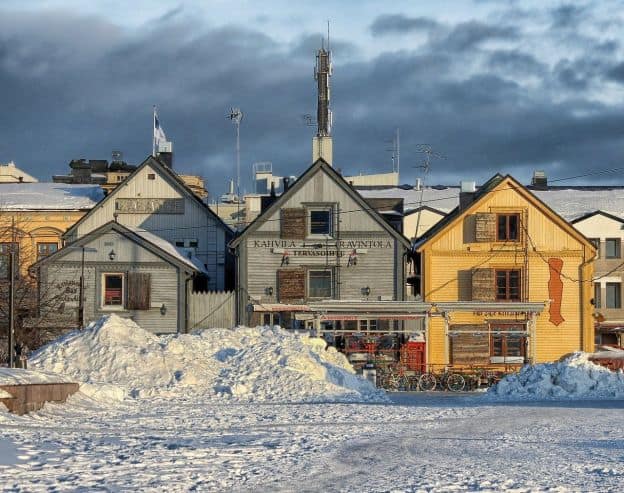
Shops in winter, Oulu, Finland
If you plan to live or work in a particular area of Finland, you might take some time to learn more about its local dialect. Especially in its spoken form, the local dialect can deviate greatly from textbook Finnish. It’s probably best to learn the more neutral Finnish standard first, then enhance your knowledge with particular dialectical variations.
Is Finnish Hard to Learn?
It is about as hard to learn Finnish as it is to learn Greek or Hungarian, based on the FSI rankings of language difficulties for English speakers. That said, the difficulty of a language depends on a lot of personal factors.
If you already speak multiple languages, you will find it easier to learn Finnish if only because you already know lots of grammar concepts! If Finnish is your first new language, you will need to learn how to learn a language as well as learn Finnish itself.
Your personal motivation can also speed up the process. If your new romantic partner speaks Finnish, you may feel super driven to learn so you can communicate in a meaningful way with someone you love.
How to Learn Finnish As an English Speaker
Finnish is rated as a Category III language by the U.S. Department of State’s Foreign Service Institute. This means that English speakers would find it about as difficult to learn as Greek, Bengali, Hungarian, Armenian, Polish, Urdu, and Farsi (Persian). That said, every learner’s experience is unique.

Helsinki Central Railway Station (detail of the National Romantic/Art Nouveau-style architecture, designed by Eliel Saarinen, and featuring statues by Emil Wikström)
We’ll look at a few characteristics of Finnish that might be easier to grasp for English speakers. Then, we’ll tackle some of the more challenging features of Finnish.
After that, we’ll talk about how to build an effective study plan. Finally, we’ll take a tour of the many resources you can use to facilitate your Finnish studies while stimulating your interest and supporting your progress toward fluency.
Easier Aspects for English Speakers
Even a complex language like Finnish can have characteristics that make learning easier. We’ll focus on a few of these that can be particularly helpful for English speakers.
Writing System
Essentially, Finnish uses the same Latin alphabet as many of its Indo-European cousins — including English. Finnish uses the same 26 letters that are found in the English alphabet, with the addition of three vowels with diacritical (accent) marks.: ä, ö, and å.
Å is called ruotsalainen O (Swedish O). This letter is primarily used in proper names that derive from Swedish. You’ll see it in placenames, especially for areas near the border between Finland and Sweden — such as the Åland Archipelago, the port of Långnäs, and the island of Kråkö.
Be mindful of these “accent marks” (diacritics), which will literally change the meaning of what would otherwise be the same word. For example, säde (ray of light) would mean sade (rain) without its accent mark. It’s helpful to think as the Finns do about this, and see a and ä as two entirely separate letters — as are o and ö.
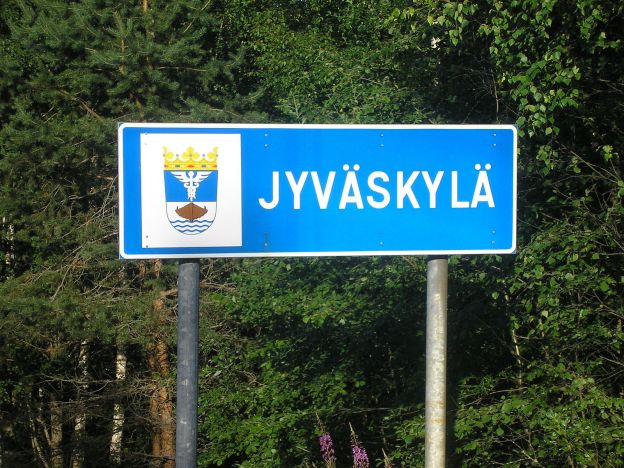
Jyväskylä city limits sign Antti Leppänen, CC BY-SA 3.0, via Wikimedia Commons
Every once in a while, you may see the letters š and ž in loanwords. And, speaking of loanwords, that’s where these so-called “borrowed consonants” can generally be found:
- b
- c
- f
- q
- w
- x
- z
Despite the few accented letters, learning to read and write in Finnish is definitely much less of a challenge for English speakers than having to learn a whole different script or set of characters, as you might for some other languages.
We’ll look at a couple of easy ways to type the accented letters in Finnish, which you can use with your regular computer keyboard. (If you’re using a virtual keyboard on a mobile device, those accented letters are likely already built in.)
Finnish Spelling and Pronunciation
As compared to English, Finnish pronunciation is fairly straightforward. In general, there is a one-to-one relationship between the letters in a word and the sounds in the word’s pronunciation. While there are some diphthongs, such as the oi combination in the words koira (dog) and poika (boy), you can sound out each vowel in the diphthong and understand how the combined vowel sound is created.
Even as a complete beginner in Finnish, I found I was quickly able to learn to spell simple Finnish words correctly when I heard them.
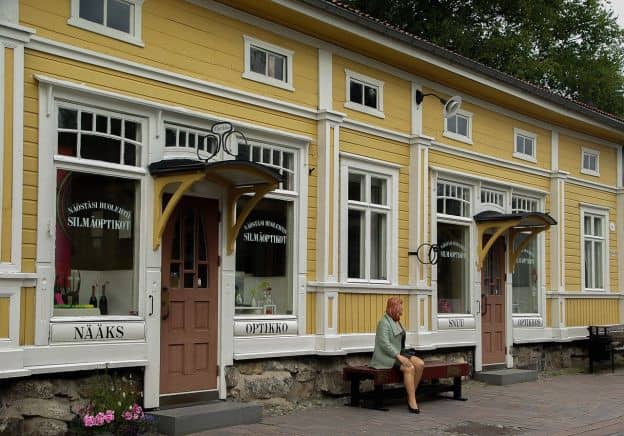
Optician’s shop, Rauma, Finland
Despite fairly uncomplicated spelling, there are a few aspects of Finnish pronunciation that could throw off English speakers.
For example, Finnish uses a rolled R, which you’ll hear in words like terve (hello) and tervetuloa (welcome). If you’re not familiar with how to produce a rolled R, there are several techniques you can try.
In a little bit, we’ll look at double letters in Finnish, which can also present a pronunciation challenge for learners.
English Loanwords
Aside from sauna, which is pronounced very differently in Finnish than in English, there are few Finnish loanwords commonly used in English.
On the other hand, Finnish has many lainasanoja (loanwords) from English, which you can recognize easily and use to build your vocabulary a little more painlessly. These are common words like idea (idea), helikopteri (helicopter), musiikki (music), kitara (guitar), and taksi (taxi).
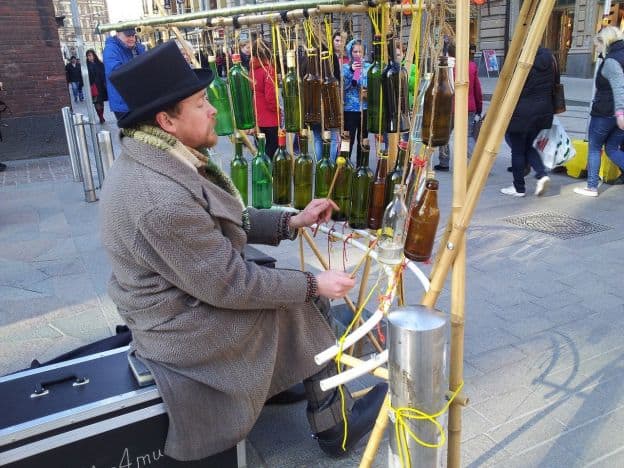
Helsinki street busker playing glass bottles
Articles
Like Russian and a host of other languages, Finnish lacks both definite and indefinite articles. Whether a noun is preceded by a “the,” or “a(n)” is determined by context.
If this sounds complicated, think about the plethora of rules needed in English to explain how these articles are used. If you’re a native English speaker, you don’t need to think twice about this. However, if you were learning English, you’d need to understand some complex rules for using articles.
When you’re learning Finnish, you may discover that it’s surprisingly easy to navigate the language without words meaning “the” or “a(n).”
Grammatical Gender
Just like English, Finnish has no grammatical gender. You’ll never have to worry about memorizing which words are masculine, feminine, or neuter.
You won’t need to make adjectives “agree” with a noun’s gender, as you would in a language like French.
And, since there are no definite or indefinite articles, you needn’t be concerned with using the correct version of “the,” as you would in Spanish—in which la, el, las, and los all mean “the,” and have to be used according to certain rules.

The ecumenical Kampin Kappeli (Kamppi Chapel of Silence), Helsinki, Finland
Subject Pronouns and Possessives
There are no gender-specific subject pronouns in Finnish. Hän is used for both “he” and “she,” as well as the gender-neutral, singular “they.”
Spoken Finnish tends to use variations on the subject pronouns. For example, minä (“I”) might be said as minä, mä, mää, or mie. It’s important to know this when you’re talking with native speakers, so you can understand them better. If you start out by using the standard, written forms, you should still be understood.
Just like in English, Finnish has different versions of each subject pronoun for use in possessives. In Finnish, possessive adjectives (like “my” in English) are the same as their corresponding possessive pronouns ( like “mine” in English.)
Whereas English has “I,” “my,” and “mine,” Finnish has minä, minun, and minun.
No Irregular Verbs
If you’re not a big fan of memorizing verb conjugations, you’ll be pleased to discover that Finnish has no irregular verbs. This means that all verbs of the same type follow the same patterns.
While there are different ways of classifying verbs in Finnish, most grammars follow the model of six standard verb types. So, once you memorize this set of half-dozen different verb conjugations, you’re set!

Love locks on Helsinki’s Bridge of Love
Syllable Stress
In standard Finnish, words of three syllables or fewer always put syllable stress on the first syllable. Although this varies in some dialects, it’s a good rule of thumb to learn so that your spoken Finnish can be readily understood.
Question Marker
In Finnish, –ko is added to the end of a conjugated verb to indicate that the verb is being used to ask a question. In some ways, -ko makes things simpler for English speakers since it makes it easier to identify questions in Finnish.
If you were asking a question for which you’d use “is” or “does” in English, you would use the Finnish verb olla (to be) in the present tense, with -ko added: Onko poika ujo? would mean, “Is the boy shy?”
The noun order is important here, just as it would be in English. If you were to ask, Onko mies velho?, it would mean, “Is the man a wizard?” On the other hand, Onko velho mies? would mean, “Is the wizard a man?”
Potential Challenges for English Speakers
Finnish has a beautiful word that embodies a concept you will call upon again and again in your Finnish studies: sisu.
There’s no direct translation to English. Sisu refers to a combination of determination, grit, inner strength, courage, tenacity, and perseverance.
Sisu will keep you going, even when you face these elements of the Finnish language that may seem difficult to grasp.
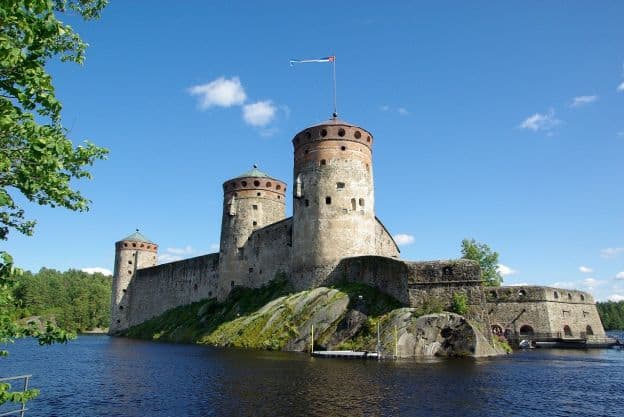
Olavinlinna (St. Olaf’s Castle), Savonlinna, Finland
Agglutinative Language
In Finnish, words are often built with individual building blocks that get stuck together, unchanged. This is called “agglutinative.” (You might think of it as “glued-together” words.)
Agglutination leads to the creation of very long words in Finnish. An interesting example is saippuakivikauppias, which means a seller of caustic (lye) or a soapstone vendor and holds the Guinness world record for “longest palindromic word” (a word that’s spelled the same backwards and forwards).
Other agglutinative languages include Japanese, Turkish, Korean, Hungarian, Swahili, and Filipino.
In many of these languages, you’ll see very long, single words used to express a complex concept — something that a language like English might use multiple words to express. The parts of these words can be broken apart like Legos, and the roots of the words don’t change.
Once you learn to recognize the root words, prefixes, and suffixes in Finnish, you actually have a better shot at decoding — that is, figuring out the meaning of new words from their component parts. This is because the components of the words themselves become modular: If you can understand the individual parts of an unfamiliar word, you can understand the whole.
A Plethora of Grammatical Cases
Words in many languages sometimes inflect (change their form) to reflect their function. In grammatical terms, we’d say that the words are in different cases. In English, you can see this with the related pronouns “I,” “me,” and “mine.”
Unlike modern English, which only has these three grammatical cases, Finnish has fifteen cases.
Because of all the cases, you might learn to express certain basic concepts, such as possession, very differently in Finnish than you would in English.
For instance: Rather than having a verb for “to have,” Finnish uses the verb olla (to be) in conjunction with a pronoun in the adessive case. This changes the ending of the pronoun representing the person who has something.
Therefore, “I have a musical instrument” would be Minulla on soitin. The pronoun minä, meaning “I” in the nominative case, is now minulla.
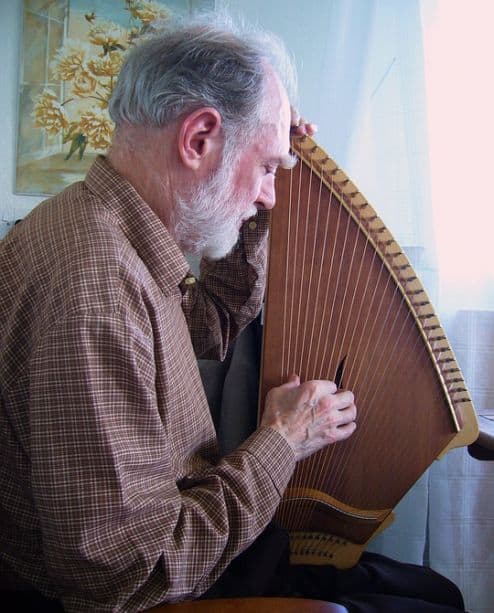
Playing the kantele (traditional Finnish stringed instrument)
Similarly, sinulla on koira would mean “you have a dog,” meillä on poni would mean “we have a pony,” and hänella on undulaatti would mean “he/she has a parakeet.”
Regardless of who owns what, olla (to be) is always conjugated in the third person singular. So, in all of these present-tense examples, it’s always rendered on.
Double Vowels and Consonants
English rarely uses double vowels — and tends not to change pronunciation much for double consonants.
In Finnish, however, it’s important to learn to hear and pronounce double vowels and consonants correctly, as they directly impact the meaning of words.
Here are a few examples; you can click on the links to hear the words pronounced by native Finnish speakers:
|
Word with Single Consonant |
Meaning in English |
Similar Word with Double Consonant |
Meaning in English |
| palo | fire | pallo | ball |
| kuka | who | kukka | flower |
| mato | worm | matto | carpet |
Vowel Harmony
Finnish has a concept called vowel harmony. It dictates which of the eight vowels in Finnish can be used with each other in a word.
In order to learn about vowel harmony, you’ll need to grasp the phonetics of so-called “back” vowels (A, O, and U, which are pronounced in the back of your mouth) versus “front” vowels (Ä, Ö, and Y, which are pronounced closer to your lips). There are also two “neutral” vowels, I and E.
Learning the rules of vowel harmony will help you with both your Finnish spelling and pronunciation.
No Future Tense
Unlike English and many other languages, Finnish doesn’t have a future verb tense. Generally, the present tense is used to talk about the future in Finnish.
A future time can be indicated by adding words and phrases like ensi viikolla (next week), ensi vuonna (next year), huomenna (tomorrow), or ylihuomenna (the day after tomorrow).
You can also use the genitive case to indicate that action will happen in the future.
A third way to talk about the future in Finnish is to use a conjugated verb like aikoa (to intend) or suunnitella (to plan), along with an infinitive (“to” form) of a verb. Think of English phrases like “I intend to travel” or “I plan to study.”
Formal and Informal Finnish
Like many languages, Finnish has both a kirjakieli (formal) and puhekieli (informal) way of saying things.
Kirjakieli, literally meaning “book language,” follows the more regimented standard of the language that’s used in writing. You’ll hear it used in formal speeches and news broadcasts.

Memorial to Aleksis Kivi, celebrated Finnish author,at the Helsinki Railway Square
Puhekieli, on the other hand, is “speech language.” It mirrors the way people speak informally, in everyday life. (You might also see puhekieli used in informal writing — like in social media, online discussion boards, or blog posts.)
As in many languages, Finnish speakers tend to shorten down the formal language when they’re using it in everyday conversation. So, for example, minä olen (I am) is usually just said as olen, since it will be obvious from the way the verb is conjugated that you’re talking about yourself.
In certain parts of Finland — notably, the south — you’ll often hear mä oon (a shortened form of “I am”) in place of minä olen.
Of course, the spoken versions of English and many other languages have such casual speech conventions. It’s not all that unusual to hear phrases like “I’m gonna” in spoken English, as opposed to “I am going to.” The trick is learning both the standard Finnish and the variations that are used in everyday speech.
Exposing yourself to authentic Finnish media, such as radio, television, films, and podcasts, is one of the best ways to hear and absorb the spoken language. We’ll look at several ways you can find such media to incorporate into your studies.
How you plan to use Finnish, in a formal or informal environment, will help you decide how much time to focus on learning kirjakieli versus puhekieli.
What’s the Best Way to Learn Finnish?
The best way to learn Finnish depends on your learning style. Fortunately, you can find a wealth of resources for any learning style listed in this article!
Once you select a handful of resources that mesh with your learning style, you need to commit to a study schedule. Try setting monthly or weekly goals for yourself and block out time every day to work toward those goals.
Make sure you celebrate when you reach a new goal!
What’s the Easiest Way to Learn Finnish?
The easiest way to learn Finnish depends on your learning style and personality. Picking study tools that support your learning style will help you engage more easily with the content.
But you also want to consider your own personality. Do you often give up because you feel like you aren’t making progress? In this case, you may want a more gamified approach that provides small wins and helps you track your progress.
If you struggle with sticking to your study schedule, you may want to learn with some accountability. You can get this by joining a language exchange app or by working with a tutor.
How Long Does It Take to Learn Finnish?
The Foreign Services Institute (FSI) estimates that it takes most English speakers 1,100 hours to gain basic proficiency in Finnish. This means about three years if you can commit to one hour a day for study.
You could shorten this timeframe by studying more intensely, of course. If you already speak multiple languages, you may also have a leg up, because your brain is more comfortable moving from one language to another.
Learn to Speak Finnish
Finnish uses some sounds that English does not, like a rolled R sound. Mastering this takes practice for your ears and your tongue. One great way to ease into learning the sounds of the Finnish language is to start with a simple exercise on an app like Duolingo.
Then try to add a listening element to your daily study time, by using audio lessons on Pimsleur or FinnishPod101, or through supplemental activities like listening to podcasts, music, or daily news in Finnish.
Of course, you can’t skip speaking Finnish, either! Pimsluer’s lessons do a great job of encouraging you to speak from day one. But you can recreate this idea for yourself by pausing a movie every few lines and repeating what the Finnish actors said. Just make sure you practice speaking Finnish aloud.
Your Plan for Learning Finnish
No matter what resources you decide to use in your studies, remember to tailor your learning to suit your style and your goals: Study when it makes the most sense for you — whether that’s early morning, late night, or during your lunch break. Focus on the most useful vocabulary for your needs.

Uspenskin katedraali (Uspenski Cathedral), an Eastern Orthodox cathedral in Helsinki, Finland
Resources that mesh well with your learning style might enable you to learn faster or remember better. For example, if you’re a visual learner, image-rich resources such as books with charts or video lessons might facilitate your learning. If you’re an auditory learner, you might favor Finnish music, radio programs, podcasts, or audiobooks.
To keep yourself motivated and learning a wide range of vocabulary, try integrating a variety of learning resources into your study routine. Look for resources that cater to your personal interests. It’s enough of a challenge to understand a text or audio in an unfamiliar language without having to force yourself to sit through material you find boring.
Even though learning a language is a serious commitment, it’s important to enjoy your experience. When we’re relaxed and having fun, our brains produce more dopamine. Dopamine is a neurochemical that gives us a pleasurable sensation, enhances memory retention, and primes our brains for learning.

Pulla (cardamom bread), a beloved part of the Finnish kahvi (coffee) ritual
Julia, CC BY 2.0, via Wikimedia Commons
Learning doesn’t have to be all formal study. Try to think of creative ways you can integrate Finnish into your life, such as baking bread using a Finnish recipe or playing Finnish word games.

Helsingin tuomiokirkko (Helsinki Cathedral), at Senate Square, illuminated by a light show
The greater the variety of stimulating activities you can incorporate into your Finnish studies, the easier it will be to sustain your motivation for learning — and to remember what you learn.
Resources to Help You Learn Finnish
Language lessons, courses, and apps are an obvious starting point when you think about learning Finnish, but having supplementary resources is equally as important. They provide additional information on the Finnish language and could be essential if and when you need reference sources as you’re learning.
Finnish Dictionaries
Duolingo’s Finnish course has a simple Finnish/English dictionary, as does FinnishPod101. The Duolingo dictionary is powered by Google Translate and provides limited information, but it can be good for a quick-and-dirty translation. The FinnishPod101 dictionary has two-speed sound clips for each word, shows related words, and even gives a few examples in context.
The Finnish-English dictionary on Suomienglantisanakirja.fi will furnish you with even more details, such as parts of speech and basic word forms. It’s also available as an Android app.

Helsinki harbor panorama
For both iOS and Android, the free Finnish dictionary app from Inspiration Apps provides translations between Finnish and twenty different languages.
Websites and Blogs
Developed by both native Finnish speakers and Finnish learners, a number of websites and blogs furnish you with Finnish vocabulary, grammar explanations, learning tips, and cultural insights, as well as lists of other resources for learning Finnish.
Finnish with Anna is ideal for beginners. She provides a handful of free Finnish worksheets in PDF format for practice. Her site links to her YouTube channel, where she tackles kielioppi (grammar) and sanasto (vocabulary).
The FinnishPod101 blog is regularly updated with articles covering topics such as YouTube channels for learning Finnish, Finnish greetings, Finnish sentence patterns, and telling time in Finnish.

Mural in Kotka, Kymenlaakso province, Finland
Venla: Finnish for beginners offers bite-sized blog entries, primarily about Finnish vocabulary, with some posts dedicated to proverbs and idioms. The Venla blog was last updated in 2017, but there are many interesting posts to explore.
Her Finland was created by Varpu, who also runs a YouTube channel with the same name and focus as the website. Both the website and the channel include cultural information, articles about the Finnish language, and posts recommending resources (such as movies, books, and TV shows) for learning Finnish. You can learn colloquialisms, such as funny Finnish phrases, that will increase your understanding of Finnish culture and worldviews.
Fairy Chamber is a blog from Niina, an artist, and native Finnish speaker. It will help you with basics like introducing yourself in Finnish, colors, months of the year, days of the week, and Finnish personal pronouns. Many of the posts are graced with Niina’s artwork. Niina also hosts a YouTube channel with a Finnish Myths & Folklore playlist. (Those videos are in English, but there are some Finnish subtitles.)
Canadian web developer Sean Potts established Study Finnish as a resource for other English-speaking learners. Although Sean is not a native Finnish speaker, he lives in Finland and gives learners a logical, well-organized guide to Finnish. There are sections of the site for Grammar and Vocabulary, as well as an “Other” section with lists of resources such as Finnish videos and YouTube channels, television and music, and documentaries about Finnish history and culture. Potts also proposes various tools and resources you can use in your quest to learn Finnish — things like inflection drills (to practice Finnish cases), additional instructional videos, and flashcard resources.
Learn Finnish by My Way is a bilingual blog. It features grammar tips, as well as suggestions for learning Finnish with social media and other resources. It might be particularly useful for helping intermediate Finnish learners strengthen their reading skills.

Think in Finnish is the brainchild of Ursula, a native English speaker who has been exposed to Finnish throughout her lifetime. Ursula’s interest led her to study the language at a university level, in addition to creating the Think in Finnish website. She uses the site to explain key Finnish concepts, such as how Finnish words are broken into syllables or how various vowel combinations appear in Finnish. Some of her discussions can get a little technical, so it might help if you already are familiar with linguistic and grammar terminology.
Intermediate and advanced learners will probably enjoy The Finnish Teacher, which supplies plentiful grammar explanations — as well as Finnish textbooks (written in Finnish).

Sunrise on a Finnish beach, in winter
Poetry
Poetry can be especially valuable for intermediate and advanced learners. It introduces symbolic and metaphorical language, as well as highlighting the rhythm and cadences of Finnish.
One of the best-known poems in the Finnish language is Kalevala. Woven together in the 19th century by Elias Lönnrot, a medical doctor and language lover, Kalevala is a multi-volume work, tells the story of creation in the Finnish and Karelian traditions. It is widely considered to be the Finnish national epic.
The Silmarillion by J.R.R. Tolkien, who also created Middle Earth and The Lord of the Rings trilogy, was strongly influenced by reading Kalevala. Tolkien even adapted the Kullervo cycle in Kalevala into prose, in a book called The Story of Kullervo. Reportedly, Tolkien also based Quenya, the Elvish language, largely on Finnish — interwoven with smatterings of Welsh, Greek, Latin, and German.
Advanced learners who wish to experience Kalevala in the original Finnish can do so through Project Gutenberg. (Gutenberg also has the English translation by John Martin Crawford.)
Luminarium hosts a small selection of Finnish poetry, including lyrical poems and works by modern poets such as Eeva Kilpi. These poems are presented in Finnish, side-by-side with Anniina Jokinen’s English translations. On the main page of the collection, Anniina includes some translation notes and discusses the place of poetry in Finnish society.
Where to Learn Finnish: Media Resources for Learning Finnish
Finland may be spoken primarily in one corner of the globe, but there’s a whole world of resources out there for learners. Mix and match different kinds of media so that you get exposure to all kinds of vocabulary in different contexts. By using written materials in conjunction with multimedia resources such as videos, you’ll be able to practice both Finnish reading and improve your understanding of spoken Finnish.

City library, Oulu, Finland
Books
Whether print or electronic, books are still one of the most valuable resources for language learning.
Phrasebooks
Phrasebooks can be a way to jumpstart your Finnish studies. They’re geared toward the needs of travelers, and they can help learners get their feet wet with basic Finnish vocabulary and common phrases.
The Finnish-English/English-Finnish Dictionary & Phrasebook by Ville Kataja is more of a phrasebook than a dictionary. However, many learners find the included phrases quite useful and practical. There are also many notes on Finnish history and culture, as well as a pronunciation guide and a section on basic Finnish grammar.
Well-known travel company Berlitz publishes a combination Finnish Phrase Book & Dictionary in paperback form. However, some learners complained that their Finnish friends found several errors in the text.
Lonely Planet’s Fast Talk Finnish is an alternative to these phrasebooks. Throughout the book, you’ll see cultural tips on everything from politely asking out your new Finnish friends to types of dishes found in Finnish restaurants. The book includes notes on regional usage, pointing out variations on common words as used in Turku, Helsinki, Oulu, and other areas. It also breaks down words into syllables, showing you where to put the stress.

Esplanadin puisto (Esplanade Park) in Helsinki, Finland
Textbooks, Grammar Books, and Workbooks
Several Finnish textbooks can get you started — or help you continue your journey — as a Finnish learner.
Terttu Leney’s Complete Finnish Beginner to Intermediate Course comes in two different formats. The paperback is pricey, but the ebook version for Kindle is more affordable. However, several people who purchased the ebook reported that the promised audio was inaccessible on many portable devices. Leney’s book is not grammar-heavy but gives you topical lessons with practical examples and cultural notes.
Maija-Hellikki Aaltio has a Finnish for Foreigners series, levels 1 and 2, with both textbooks and workbooks. The lessons in the series seem to offer more grammar instruction than Leney’s Complete Finnish text. With relatively short lessons, learners found the series thorough yet easily digestible.
Leila White’s From Start to Finnish: A Short Course in Finnish is thorough, with lots of good grammar explanations. It also includes exercises with an answer key. However, even used copies are not inexpensive.

Using an e-reader to study Finnish
Finnish Tutor: Grammar and Vocabulary Workbook, by Dr. Riitta-Liisa Valijärvi, provides a wealth of exercises for students at the advanced beginner to upper intermediate levels (A2 through B2 on the CEFR scale). In addition to the grammar exercises, you’ll find exercises to strengthen your Finnish reading and writing skills. You might want to use this in conjunction with a comprehensive Finnish grammar book, however, as several learners found it lacking in essential grammar explanations. Some people also felt that the book was more suited to learners at an intermediate to advanced level.
Intermediate and advanced Finnish learners with some background in linguistics might appreciate Finnish: An Essential Grammar by Fred Karlsson. This book, part of the Routledge Essential Grammars series, is a comprehensive grammar reference that’s available in hardcover, paperback, or as a Kindle ebook.
More economical alternatives to these textbooks are available. The Suomen kielioppi (Finnish Grammar) site has a downloadable PDF of Finnish grammar, circa 2004, available for free.
If you’re a logical-mathematical learner who’d like to get highly technical about Finnish pronunciation, check out Finnish Sound Structure: Phonetics, phonology, phonotactics and prosody by Kari Suomi, Juhani Toivanen and Riikka Ylitalo. This free, downloadable PDF from the University of Oulu digs deep into topics such as pronunciation, vowel harmony, vowel sequences, and even speaker intonation.
Graded Readers, Bilingual Books, and Children’s Books
Both graded readers and bilingual books are helpful tools for easing into Finnish reading. Many graded readers are also bilingual, giving beginning learners the support they need to understand the Finnish texts.
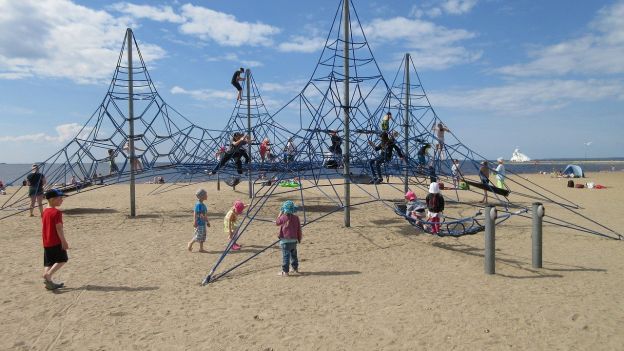
Nallikari seaside resort, Hietasaari district, Oulu, Finland
First Finnish Reader for beginners by Enni Saarinen is a bilingual, English-Finnish reader. It uses repetition to help you remember the Finnish words you encounter. The stories in the reader dramatize real-life situations such as looking for a job, meeting people, shopping, and studying. Each story is introduced with a glossary, and the Finnish and English texts are side-by-side in the paperback edition. (Although the Kindle (ebook) edition is about half the price of the paperback, some readers complained that the bilingual texts are not displayed on the same pages — so it may not be as good of a value as the paperback version.) The book, which can be used with its accompanying MP3 audio tracks, has material for learners at an elementary level of Finnish to a low intermediate level. You can sample it as a PDF with embedded audio; be warned, however, that the audio files will open in the same browser tab as the text. The series continues with a second volume from the same author. Learn Finnish: Parallel Text from Polyglot Planet Publishing offers you a line-by-line, stacked English translation of the Finnish text. Unlike the Saarinen series, this book does not appear to have any vocabulary lists or glossaries. It is supposed to be designed for beginning learners, though. One downside may be that the book contains merely four stories. After the sections with parallel Finnish-English text, the same stories are presented completely in Finnish, then completely in English. This may be beneficial if you wish to test your retention of Finnish vocabulary; it removes the temptation to look down at the English text as you’re reading through the Finnish.In addition to these graded readers, there are several bilingual children’s books you can use for practice, such as Grimmin Satuja (Grimms' Fairy Tales) from Svetlana Bagdasaryan’s My Grandma’s Tales collection or Villijoutsenet – The Wild Swans, an adaptation of Hans Christian Andersen’s work from Ulrich Renz’ Children’s Bilingual Books series.
Sujatha Lalgudi offers a few Finnish-English bilingual books, including Counting Fun / Laskemisen ilo, Where is the Baby / Missa vauva on, My daddy is the best / Minun isani on paras, and Jojo’s Easter Egg Hunt / Jonne ja pääsiäismunan metsästys.

Outdoor “living room,” Oulu Lake
Elly Gedye’s Eva the Adventurer / Seikkailija Eeva,, translated by Leena Vesterinen and Elli-Stina Parssinen, brings the fantastic voyages of a young lady to Finnish learners through charming illustrations and simple sentences.
Beyond children’s literature, you can find a bilingual version of the New Testament, which will introduce you to a broader range of vocabulary and more complex sentence structures.
When you’re ready to move beyond bilingual books to full Finnish texts, you might try Helsinki-based author Tuula Pere. She has several heartwarming children’s stories, such as Oopperan hiiri (Opera Mouse), Laakson kehtolaulu (The Lullaby of the Valley), or Lauri – pikku matkamies (Lauri, a Little Traveler).
Fiction and Non-Fiction Books
Online shop Book Depository has an astonishing array of titles for Finnish learners. You’ll find everything from textbooks and children’s books to Harry Potter and Disney stories — as well as romance novels, thrillers, biographies, and fantasies. In addition to many translated works, such as Hobitti (The Hobbit) by J.R.R. Tolkien, there are dozens of homegrown Finnish works.
Once you’ve graduated to intermediate or advanced Finnish lessons, you can try more challenging reading. In addition to the myriad titles on Book Depository, online retail giant Amazon offers a few selections on different topics:
- Learn about the Finnish Civil War through the eyes of celebrated author Frans Eemil Sillanpää in his acclaimed work, Hurskas kurjuus (Meek Heritage).
- Submerse yourself in more history with Kallista hiekkaa: Suomalainen muukalaislegioonalainen Algerian sodassa (Expensive Sand: A Finnish Alien Legionnaire in the Algerian War) by Jaakko Sarlin-Lappeteläinen, as told to Heli Santavuori.
- Explore existentialist thought with Suomalainen eksistentialismi (Finnish Existentialism) by Teemu Jokela.
- Suomalainen transiittikirja: Elämän käännekohtia planeettojen rytmissä (Finnish transit book: Turning points in life in the rhythm of planets) by Raimo Nikula can be your guide to Finnish astrology.
- Take a virtual journey to northeast Finland and Lapland with this beautiful coffee-table book, Suomalainen maisema: Lappi ja Koillismaa (Finnish Landscapes: Lapland and the Northeast).
- Circumnavigate the globe with a Finnish translation of Jules Verne’s classic, Maan ympäri 80 päivässä (Around the World in Eighty Days).
- Devote yourself to Finnish reading with the well-known texts found in Suomalainen Latinalainen Raamattu (the Finnish Latin (Vulgate) Bible). This Kindle ebook edition has verse-by-verse navigation and text-to-speech (machine-generated) narration.
Works by contemporary authors can give advanced learners even more insight into current Finnish culture.
Free eBooks and Audiobooks
Finnish learners need not look far for free ebooks. Project Gutenberg offers over 2,000 works, including translations from other languages. You can read these online, or download them in various formats (including MOBI for Kindle, EPUB, and plain text).
Farkas Translations has a small handful of works translated into Finnish, such as Alice in Wonderland, The Hound of the Baskervilles, and The Call of the Wild. You can read these side-by-side with their English versions; some are also available in French, Swedish, Italian, and a few other languages.

Enjoying a Finnish audiobook
For auditory learners and others who want to practice their Finnish listening skills, LibriVox has about two dozen audiobooks to try. These include poetry and short stories.
Loyal Books has both free ebooks and audiobooks in Finnish, available in several downloadable formats. There’s a short summary, in both English and Finnish, for each book.
Finnish News Online
News in plain language is available through the Finnish national broadcasting company, Yle. Each story is narrated clearly, at a slow pace, and captioned in Finnish.
Finland today boasts around three hundred newspapers, so you’ll have no shortage of current-events reading material!
Here are a few you might check out:
- Kaleva: Established in 1899, this paper is headquartered in Oulu and is known for some investigative journalism.
- Kauppalehti (“Trade Newspaper”): Based in Helsinki, it focuses on commerce, trade, and financial news.
- Turun Sanomat (“Turku Dispatch”): Considered the top regional newspaper in Southwest Finland, this paper is published in Turku.
- Aamulehti (“Morning Newspaper”): Published in Tampere, western Finland, this daily was founded in 1881.
- Helsingin Sanomat (“Helsinki Times”): Frequently called Hesari and sometimes simply “HS,” this is a newspaper of record in Finland.
- Iltalehti (“Evening Newspaper”): A relative newcomer, Iltalehti was founded in 1980 and is published six times weekly in Helsinki.
- Ilta-Sanomat (“The Evening News”): The largest and most direct competitor to Iltalehti, this tabloid has been around since 1932. It’s also based in Helsinki.
To facilitate reading newspapers and other online content, we find a tool such as Readlang helpful to gloss unfamiliar words. Currently, ReadLang can be used with the Chrome browser; you can also use it to make flashcards.
Finnish Music and Radio
Auditory inputs like radio programs and music are great for learning in hands-free mode.
You can live stream hundreds of Finnish radio broadcasts through several websites, including TuneIn, Streema, Online Radio Box, and Live Online Radio. Several of these services also offer apps for your mobile device.
Many sources of Finnish music — in a plethora of genres — can be found online. Amazon boasts thousands of Finnish songs and albums in a wide variety of genres. Search for Finnish music or suomalainen musiikkia on Spotify for many more selections.

Finding Finnish music on Spotify
YouTube gives learners a huge variety of Finnish music, accompanied by images (and sometimes, lyrics.)
Television and Movies for Finnish Learners
To expand your exposure to Finnish as it’s used in entertainment, tune in to Finnish TV programming and try some Finnish cinema. These are programs and films that native Finnish speakers might watch — and they can even serve as conversation starters for you and your Finnish conversation partners.

Take advantage of your TV time to improve your mastery of Finnish
Finnish Television
Fear not: Finnish television programming isn’t really as portrayed on Saturday Night Live’s Finnish Talk Show.
There’s a good deal of variety, with shows to suit all different kinds of tastes and interests.
Some Finnish TV shows are available for streaming online from Yle, Finland’s national broadcasting company.
Find global culinary adventure with Voiko tätä syödä? ( “Can This Be Eaten?”), a documentary series in the spirit of Anthony Bourdain: No Reservations.
Luottomies (“Wingman”; sometimes called “Credit Man”) is a buddy comedy following the adventure of neighbors Tommi and Juhis. You can watch it with English subtitles or Finnish captions.
Stan Saanila and André Wickström are a Finnish comedy duo who lampoon current events and politics in their series Tämä tästä (“This Here”).
On the other side of the spectrum from comedy, Rankka vuosi (“Tough Year”) is a documentary series about the coronavirus pandemic in Finland.
Many more Finnish TV shows are available on the Yle Areena channel on YouTube.
Through Prime Video and the ad-supported IMDbTV service, Amazon presents a few Finnish series. Look for shows such as Helppo elämä (“Easy Living”), about a man who turns to crime to support his family, and Koukussa (“Hooked”), the story of a narcotics agent with a huge conflict between his career and his personal life. For fans of dark comedies like Dead to Me, there’s Mustat lesket (“Black Widows”), which tells the tale of three desperate wives.
Somewhat surprisingly, Netflix has few Finnish series on offer, although you might find the crime dramas Karppi (literally, “Carp,” but called “Deadwind” in English) and Sorjonen (called “Bordertown” in English). Availability of series can vary, depending on the country where you access Netflix. It’s worth checking back every few months to see if new Finnish programming has been added.
You might also be able to access Finnish television programming over your streaming device, possibly for a small monthly charge. Through your Roku, for example, you can access Finland TV, which would typically have regional channels and local programming.
At this time, Hulu, Sling, AT&T/DirecTV, and DISH Network offer no Finnish-language programming packages.
Finnish Films
There are over one hundred years of Finnish cinema to explore as you improve your command of the language. Here are a few more recent picks that you can find on streaming platforms.
Armoton maa (which translates as “Ruthless Land,” but is called “Law of the Land” in English) is an intense action drama. A police officer must live with the criminal actions of one son while facing the outrage of another.
Tie pohjoiseen (“Road North”) is a road-trip dramedy, in which estranged family members try to connect for the first time.
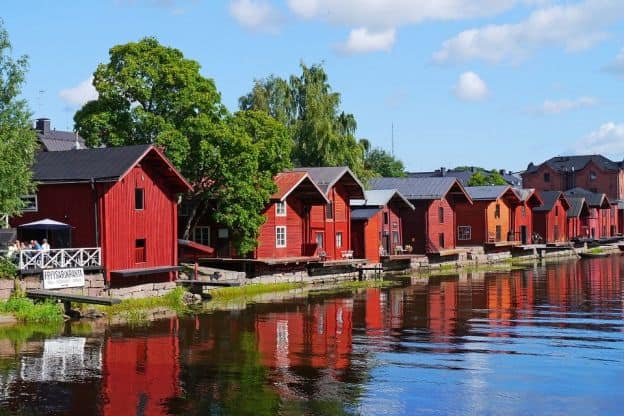
Wooden houses in the historic center, Porvoo, Uusimaa Region, Finland
For a different kind of road trip, try Hevi reissu (“Heavy (Metal) Trip”), a crass comedy in the spirit of Detroit Rock City and the animated series Metalocalypse.
Humor and science fiction fans alike might enjoy Star Wreck: In the Pirkinning, which is available for free on YouTube, and subtitled in ten languages. (The English subtitles are open-captioned, meaning that they can’t be removed from the video.) Part of an ongoing series, this screwball comedy parodies both Babylon 5 and Star Trek. You can also download it from the Internet Archive.
Additional films you might find through online Finnish media stores:
- Etsinnässä (“Searching for You”) follows the summertime adventures of Joni, as he travels and tries to find meaning in his young life
- Tali–Ihantala 1944, called “1944: The Final Defence” in English, is an historical war film named after a battle site
- Tuntematon Sotilas (“The Unknown Soldier”), based on a famous 1954 novel by celebrated author Väinö Linna
- Autio maa (“Forsaken Land”) is a post-apocalyptic film about twin Finnish brothers
- Teidät tuomitaan elinkautiseen (“You Will Be Sentenced to Life”) is the story of a solitary prisoner whose life takes a dramatic and unexpected turn for the better
- Ricianne Razen tells the tale of its main character, Ricianne, and her interactions and misadventures with friends
Movies can give you a glimpse into everyday Finnish life and language, as well as insight into key points in Finnish history.

Kittilän lentoasema (Kittilä Airport), Finland, located inside the Arctic Circle
As an old Finnish saying goes, ei kukaan ole seppä syntyessään (“no one is born a blacksmith”). In other words, learning to be proficient at any skill takes time, and you will need to allow yourself to make mistakes.
Learning Finnish well takes a great deal of sisu — inner strength, tenacity, determination, and commitment. If you take advantage of the many helpful resources available, you can keep the process interesting, enjoyable, and productive.
Soon, you will reap the rewards for your efforts as you find yourself able to appreciate Finnish films, literature, music, and more in their original language. And you’ll be able to express yourself confidently suomen kielellä (in the Finnish language).
Related Posts
If you found this article useful, you might also like:

